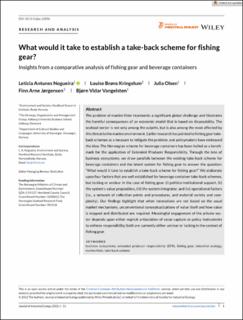| dc.contributor.author | Antunes Nogueira, Leticia | |
| dc.contributor.author | Kringelum, Louise Brøns | |
| dc.contributor.author | Olsen, Julia | |
| dc.contributor.author | Jørgensen, Finn Arne | |
| dc.contributor.author | Vangelsten, Bjørn Vidar | |
| dc.date.accessioned | 2024-01-30T14:53:34Z | |
| dc.date.available | 2024-01-30T14:53:34Z | |
| dc.date.created | 2022-08-01T16:15:44Z | |
| dc.date.issued | 2022 | |
| dc.identifier.issn | 1088-1980 | |
| dc.identifier.uri | https://hdl.handle.net/11250/3114621 | |
| dc.description.abstract | The problem of marine litter represents a significant global challenge and illustrates the harmful consequences of an economic model that is based on disposability. The seafood sector is not only among the culprits, but is also among the most affected by this threat to the marine environment. Earlier research has pointed to fishing gear take-back schemes as a measure to mitigate the problem, and policymakers have embraced the idea. The Norwegian scheme for beverage containers has been hailed as a benchmark for the application of Extended Producer Responsibility. Through the lens of business ecosystems, we draw parallels between the existing take-back scheme for beverage containers and the latent system for fishing gear to answer the question: “What would it take to establish a take-back scheme for fishing gear?” We elaborate upon four factors that are well established for beverage container take-back schemes, but lacking or unclear in the case of fishing gear: (i) politico-institutional support, (ii) the system's value proposition, (iii) the system integrator, and (iv) operational factors (i.e., a network of collection points and procedures, and material variety and complexity). Our findings highlight that when innovations are not based on the usual market mechanisms, unconventional conceptualizations of value itself and how value is mapped and distributed are required. Meaningful engagement of the private sector depends upon either explicit articulation of value capture or policy instruments to enforce responsibility; both are currently either unclear or lacking in the context of fishing gear. | |
| dc.description.abstract | What would it take to establish a take-back scheme for fishing gear? Insights from a comparative analysis of fishing gear and beverage containers | |
| dc.language.iso | eng | |
| dc.relation.uri | https://onlinelibrary.wiley.com/doi/10.1111/jiec.13296 | |
| dc.title | What would it take to establish a take-back scheme for fishing gear? Insights from a comparative analysis of fishing gear and beverage containers | |
| dc.title.alternative | What would it take to establish a take-back scheme for fishing gear? Insights from a comparative analysis of fishing gear and beverage containers | |
| dc.type | Peer reviewed | |
| dc.type | Journal article | |
| dc.description.version | publishedVersion | |
| dc.source.journal | Journal of Industrial Ecology | |
| dc.identifier.doi | 10.1111/jiec.13296 | |
| dc.identifier.cristin | 2040449 | |
| dc.relation.project | Miljødirektoratet: QZA-15/0137 | |
| dc.relation.project | Fiskeri- og havbruksnæringens forskningsfinansiering: 901518 | |
| dc.relation.project | Nordland fylkeskommune: 5250031 | |
| cristin.ispublished | true | |
| cristin.fulltext | original | |
| cristin.qualitycode | 2 | |
